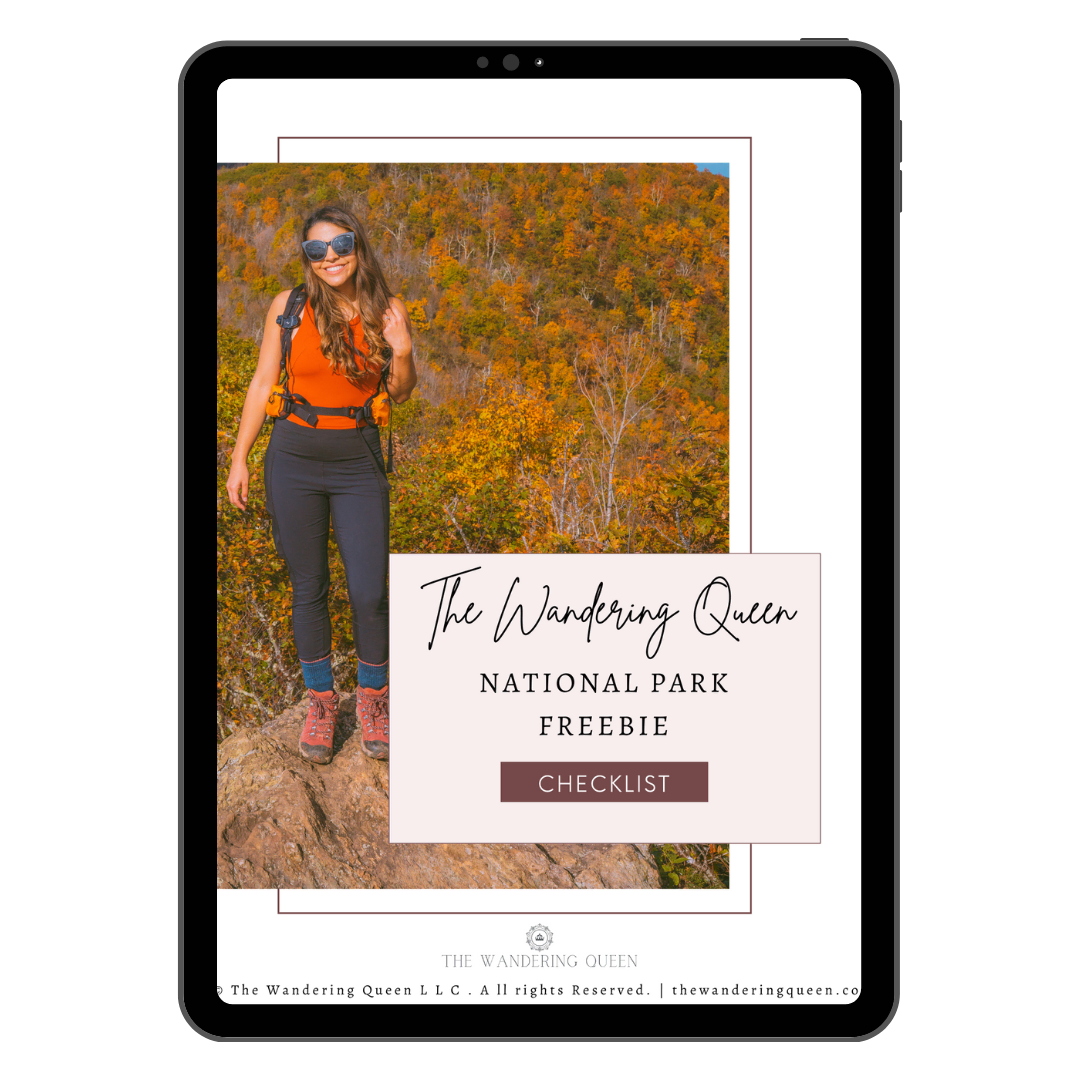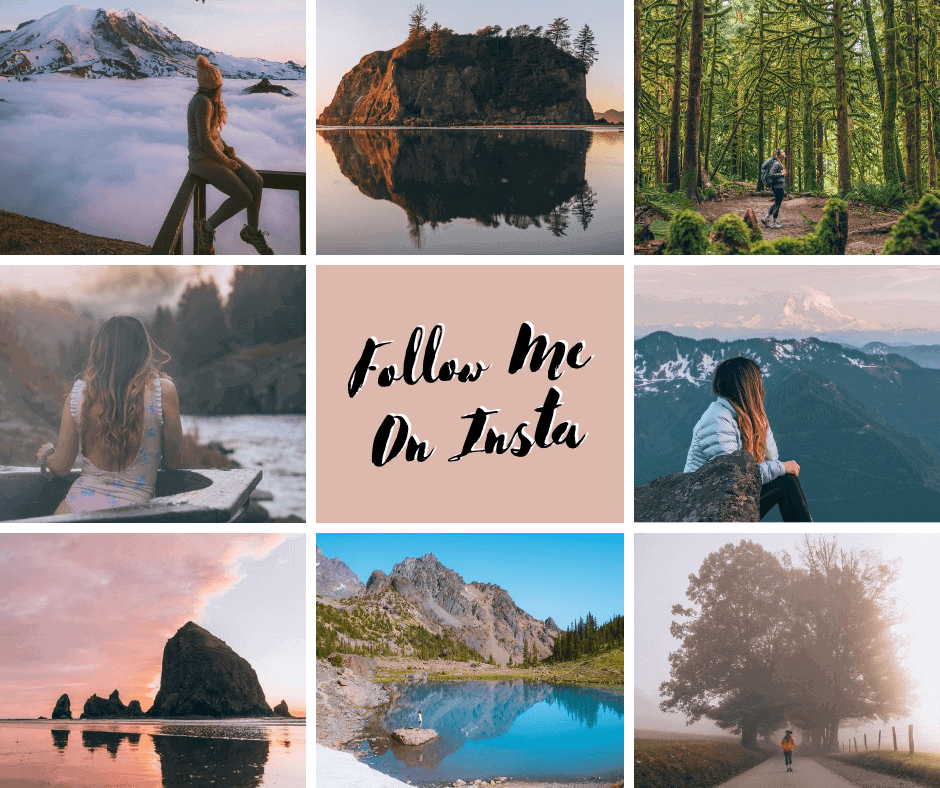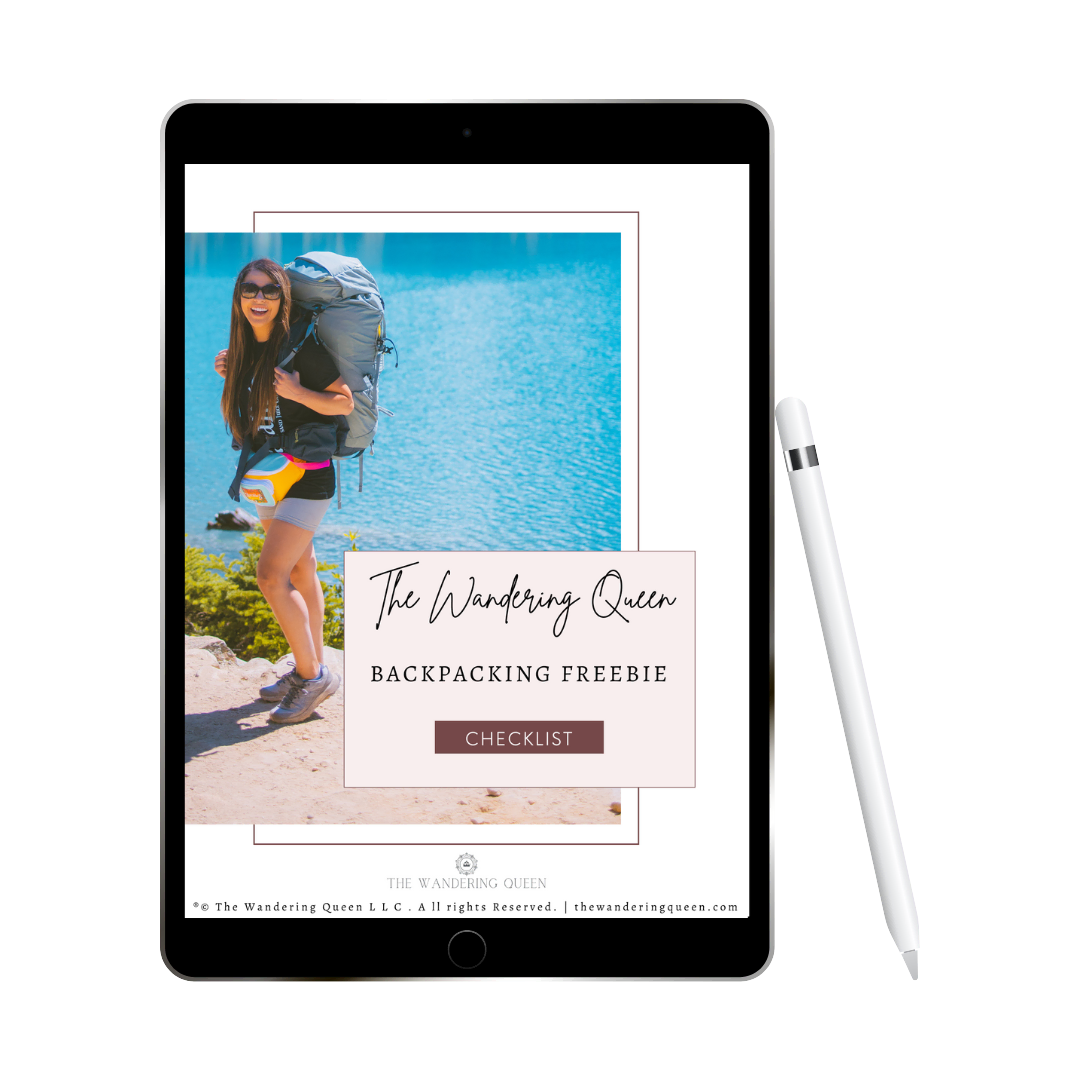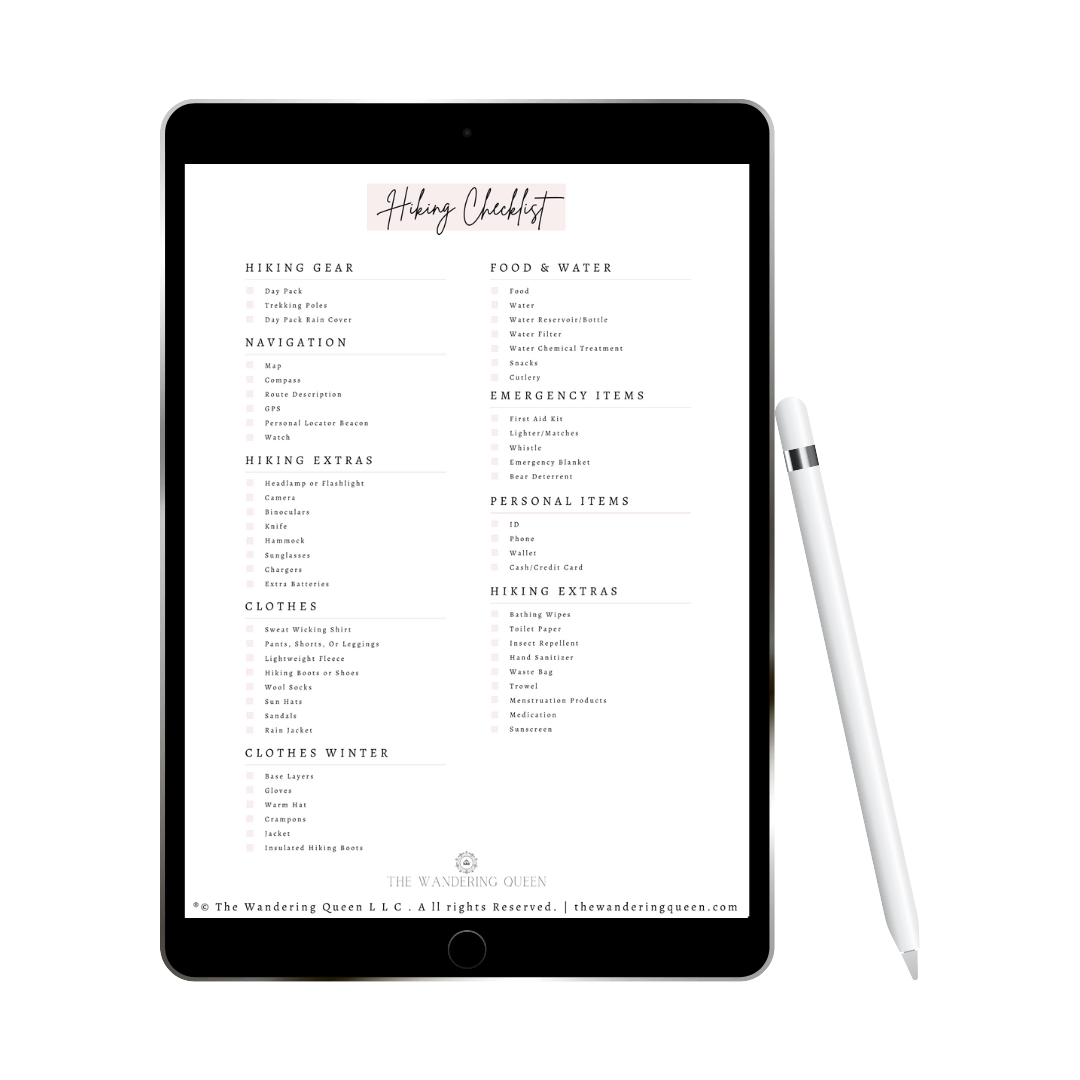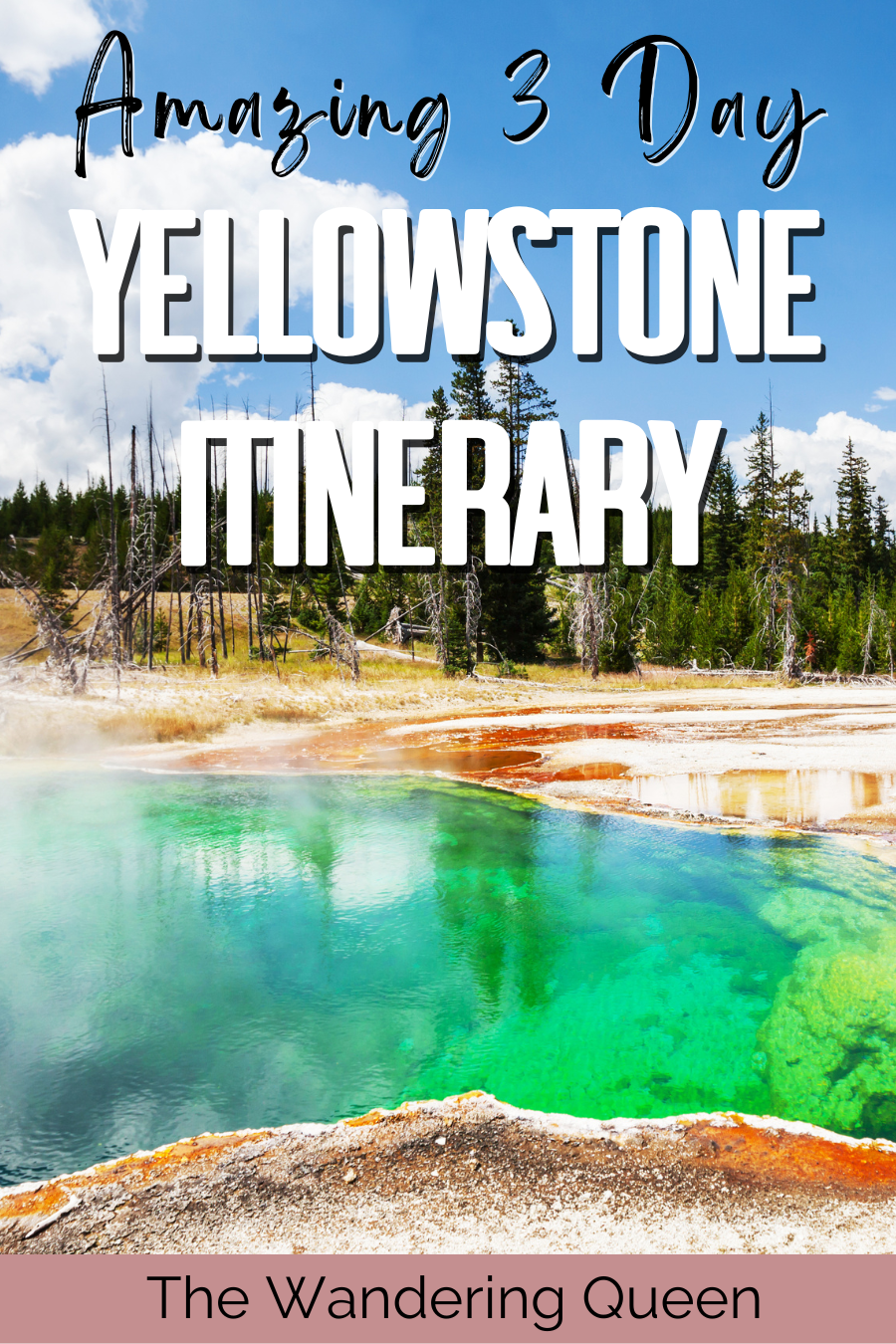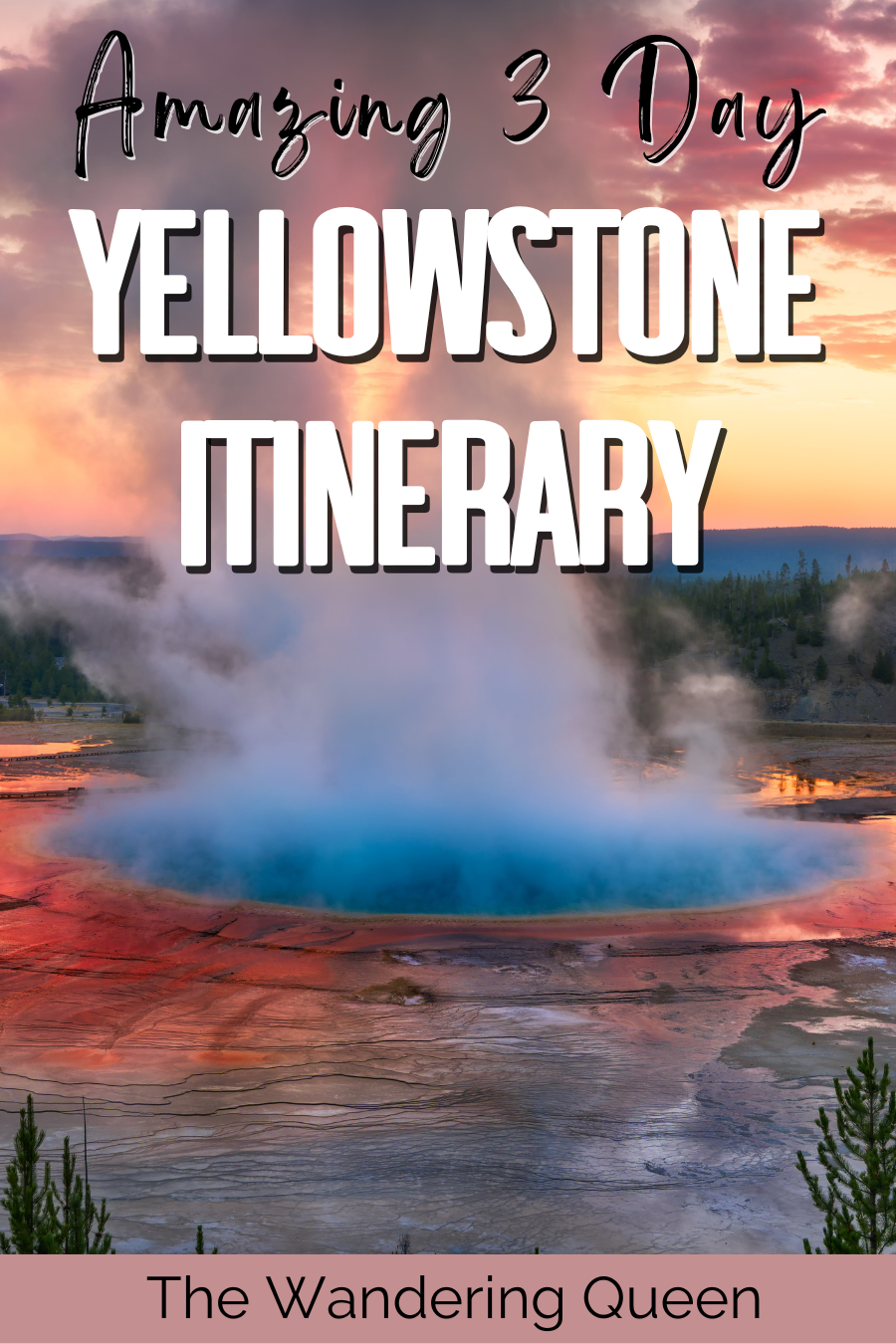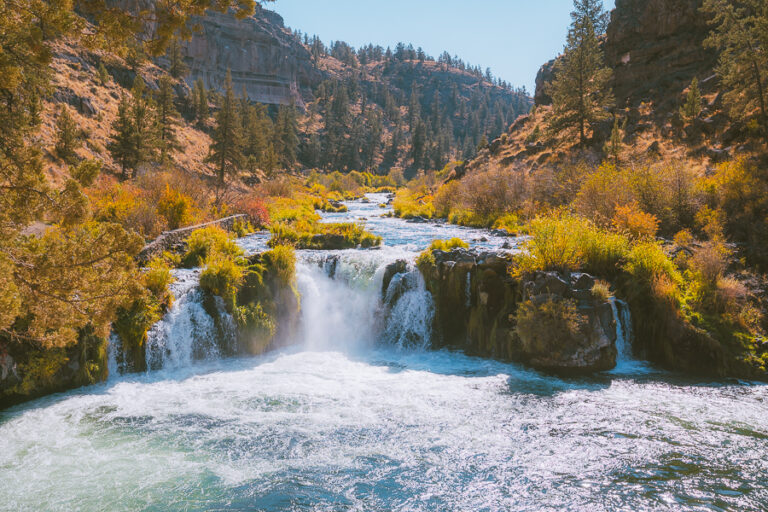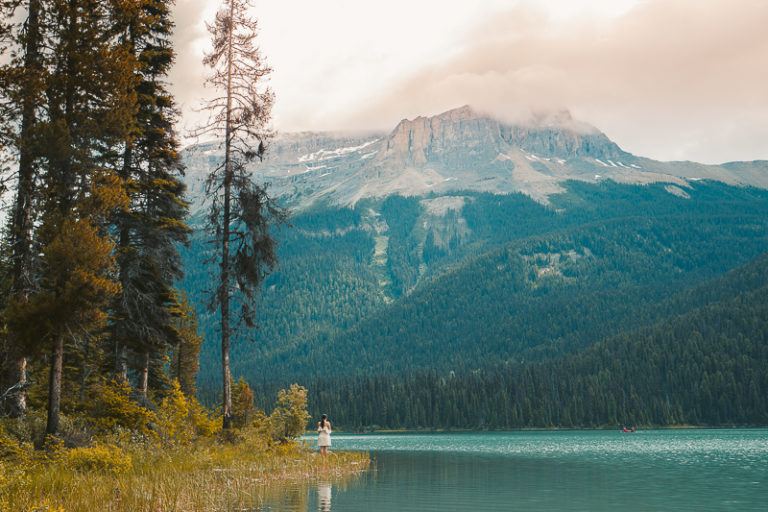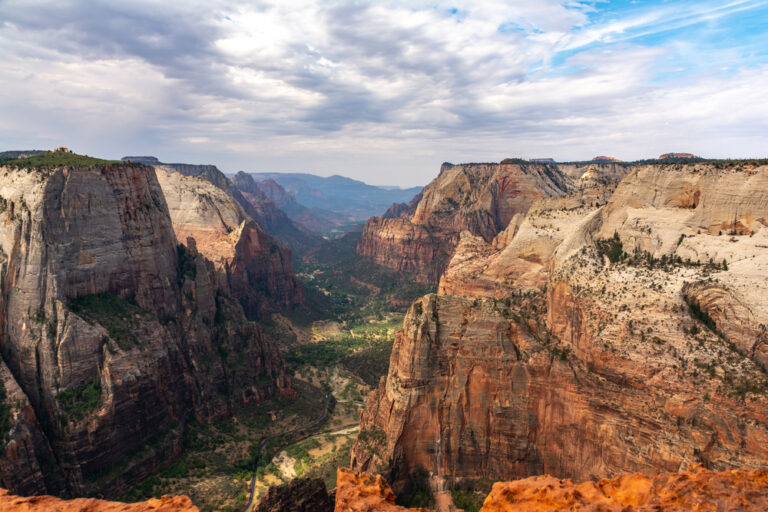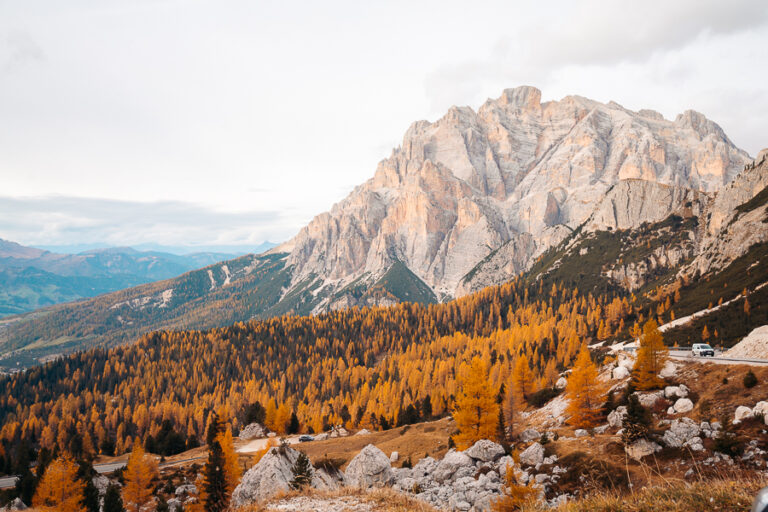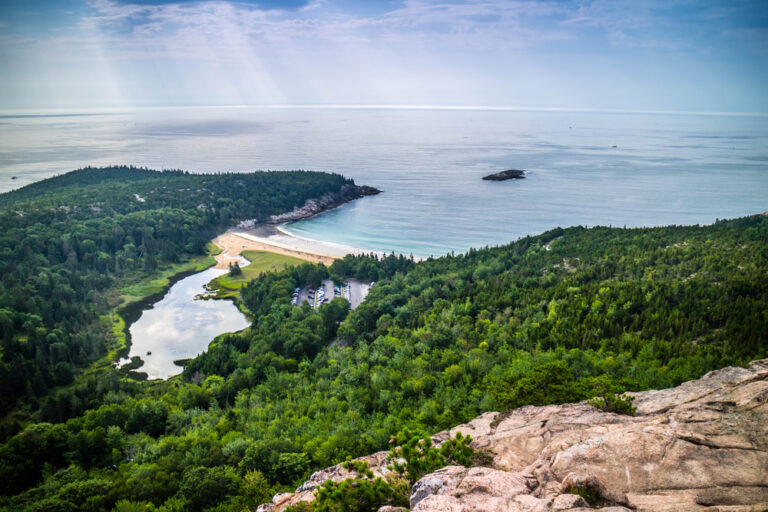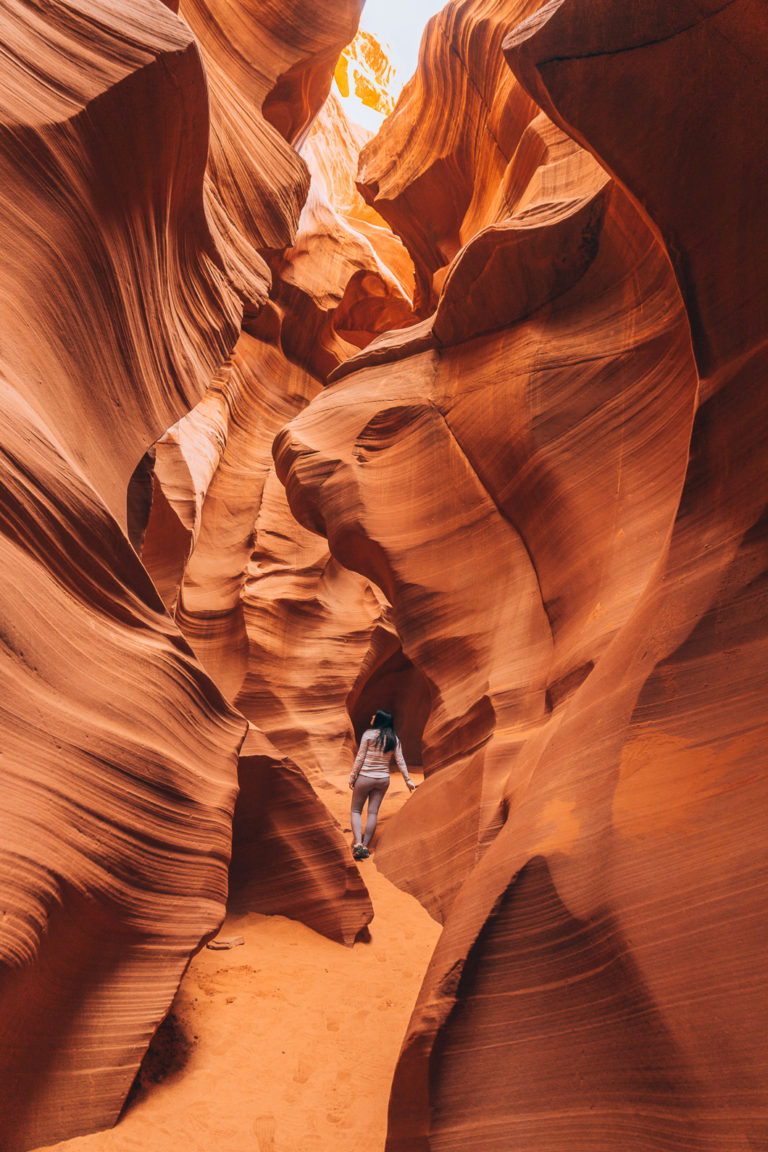Amazing 3-Day Yellowstone Itinerary | Ultimate Travel Guide
Dotted with lots of geothermal wonders, frolicking wildlife, and breathtaking natural scenery, Yellowstone National Park will leave you in awe. From admiring bubbling hot springs to hiking trails that end at cascading falls, this 3-day Yellowstone itinerary has got you covered.
Enjoy tons of fun things to do in Yellowstone, including learning about its history and how it became the first national park in the world. This in-depth guide details everything you’ll need, from when to visit Yellowstone National Park to where to stay during your trip and more.
Now, enough small talk; let’s dive into what this magnificent park has in store for you!
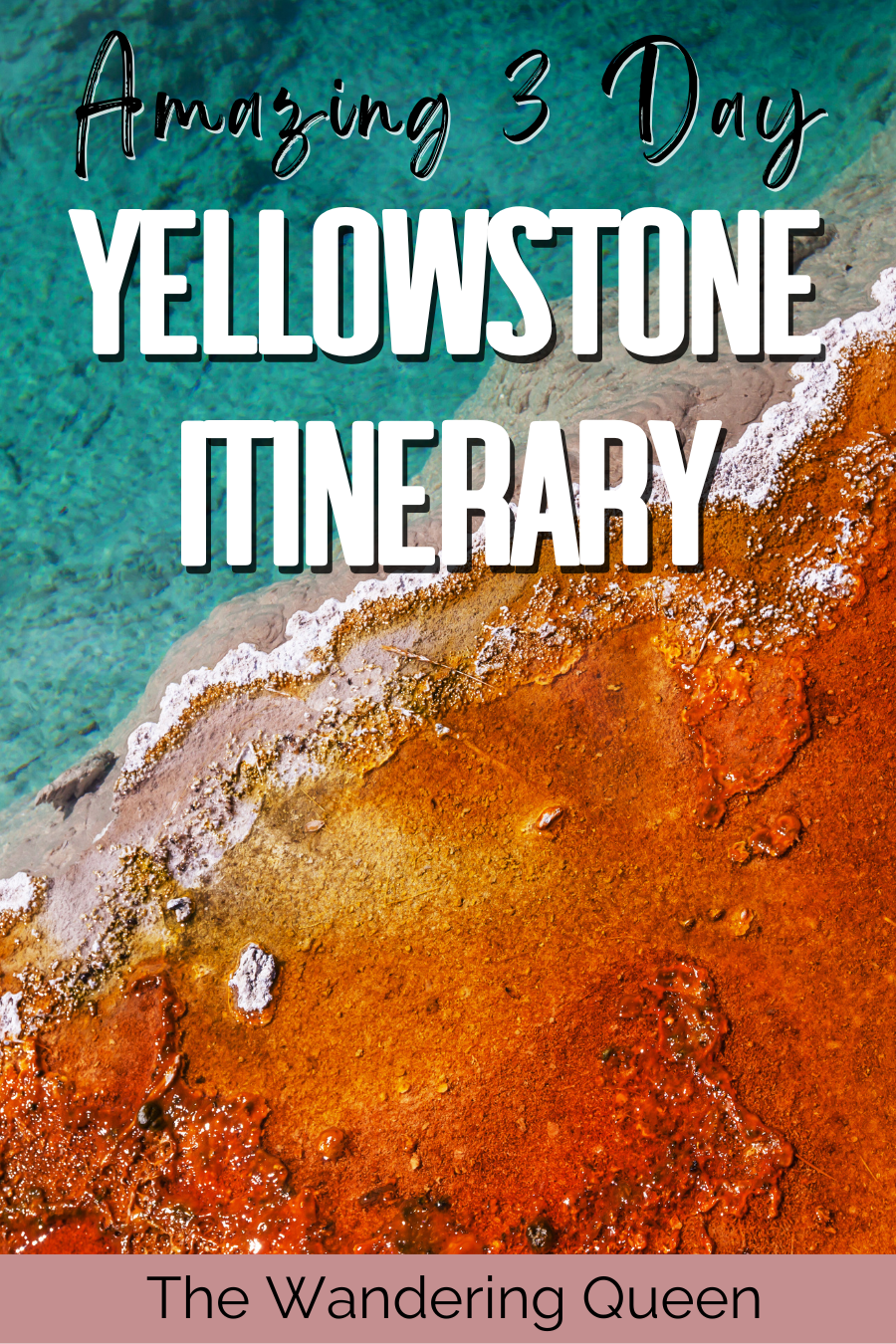
Disclosure: This post contains affiliate links. If you click one of them, I may receive a small commission (for which I am very grateful for) at no extra cost to you.
YELLOWSTONE National Park
Related Posts
Map Of Yellowstone Itinerary
A Complete Yellowstone 3-Day Itinerary
Whether you’re looking for scenic drives and hiking trails to marvelous geothermal features or keen on spotting the frolicking wildlife, these 3 days in Yellowstone have got you covered.
Here’s the ultimate itinerary for an unforgettable three days in Yellowstone National Park.
Day 1 of Your Yellowstone National Park Itinerary
Day one of your Yellowstone itinerary kicks off with a bang, taking you from a soothing waterfall to one of the park’s most iconic attractions and a couple of hidden gems.
Hike to Lewis Falls
- Distance: 0.12 miles out-and-back
- Elevation Gain: 29 feet
- Difficulty: Moderate
- Trail Guide: Link
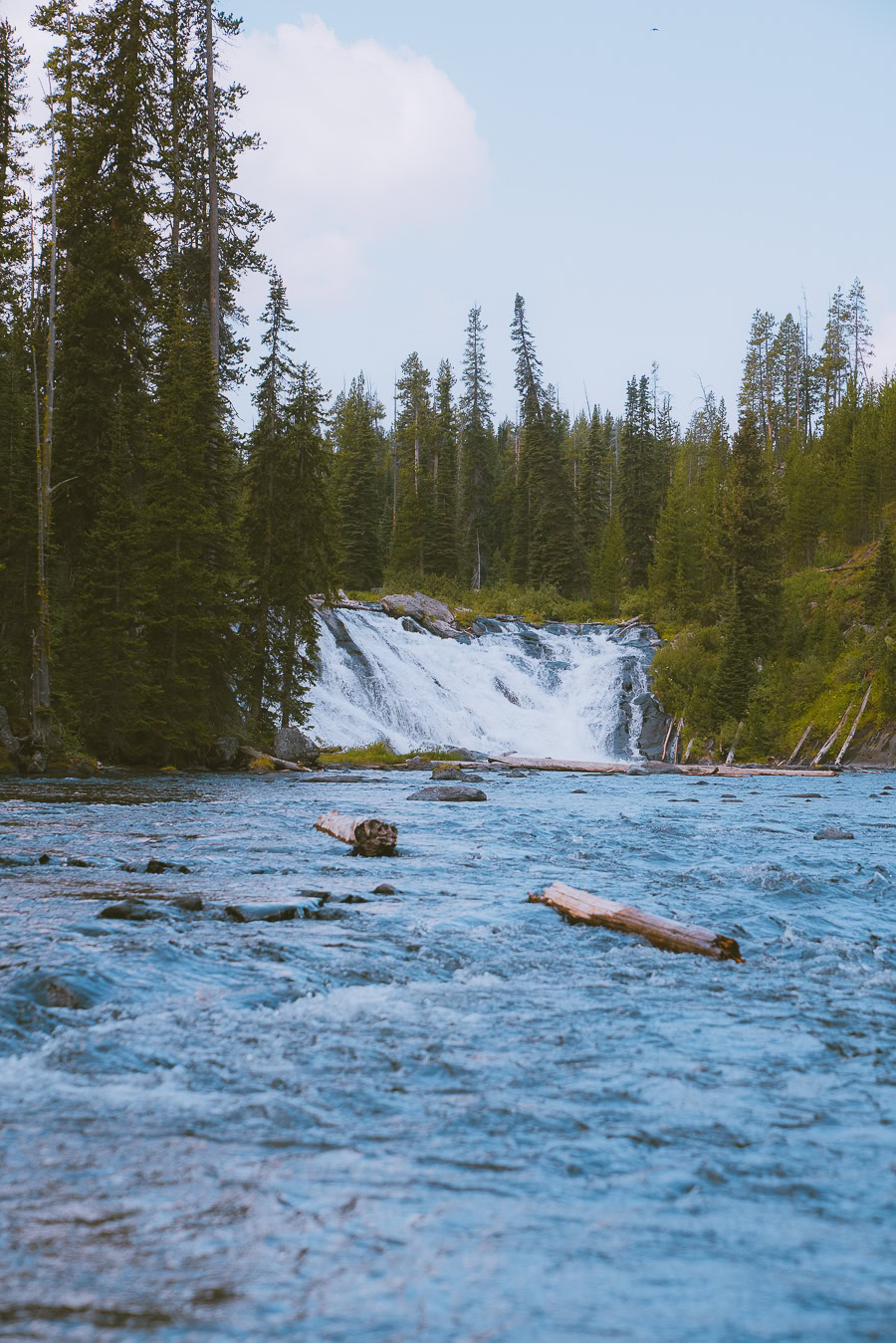
Nestled along the Lewis River, close to the South Entrance of Yellowstone National Park, these cascading falls offer a serene setting ideal for nature photography and relaxation. Tall cliffs speckled with lush trees frame the falls, creating exceptional views.
This short 0.12-mile out-and-back trail is considered moderately challenging but easily doable in just under 10 minutes. The trail begins off South Entrance Road. Cross the bridge and head west toward the falls. Be sure to bring a good camera to capture the pretty scenes.
Admiring Lewis Falls is undoubtedly the most popular activity; however, fishing and camping are also great ways to spend time here. Lewis River is abundant with fish like brown and brook trout, so after marveling at the falls, you can easily go fishing along the river.
Marvel at the West Thumb Geyser Basin
- Distance: 1 mile loop
- Elevation Gain: 62 feet
- Difficulty: Easy
- Trail Guide: Link
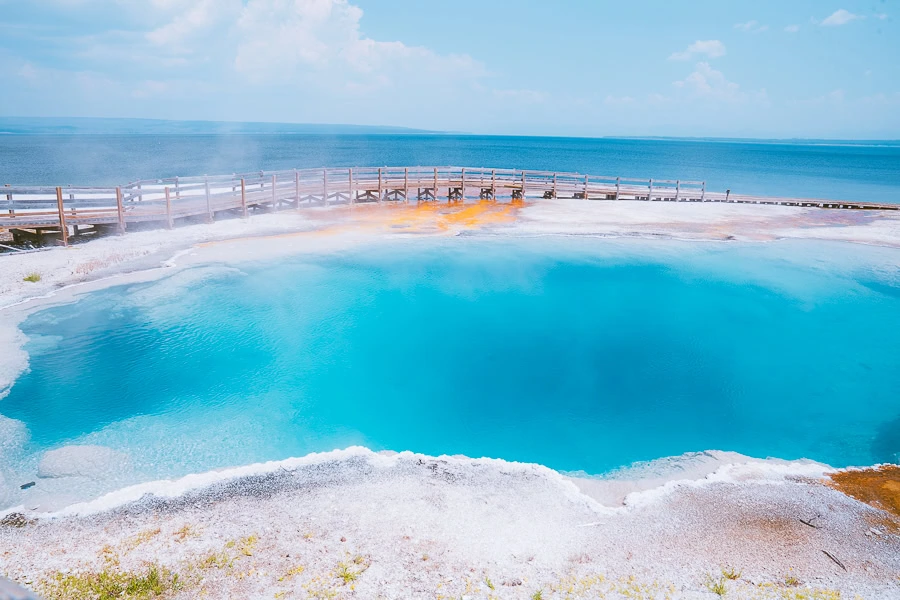
Tucked along the shores of Yellowstone Lake, the West Thumb Geyser Basin is an excellent place to witness the park’s incredible geothermal activity. These hot springs and colorful pools offer unparalleled views, with a surreal landscape against the backdrop of lush forests.
Considered relatively easy to complete, this one-mile loop trek takes you through several pools and geysers, like the Fishing Cone, the Abyss Pool, and the Black Pool. Walk along the boardwalk trails, admiring the hot springs as you weave around the basin in a loop.
Before heading off to your next stop, visit the West Thumb Information Station to learn more about the area’s geothermal activity. You’ll find a park store, as well as a couple of public restrooms in the parking lot.
Download my free Outdoor Photography Guide
Stop by the Mud Volcano
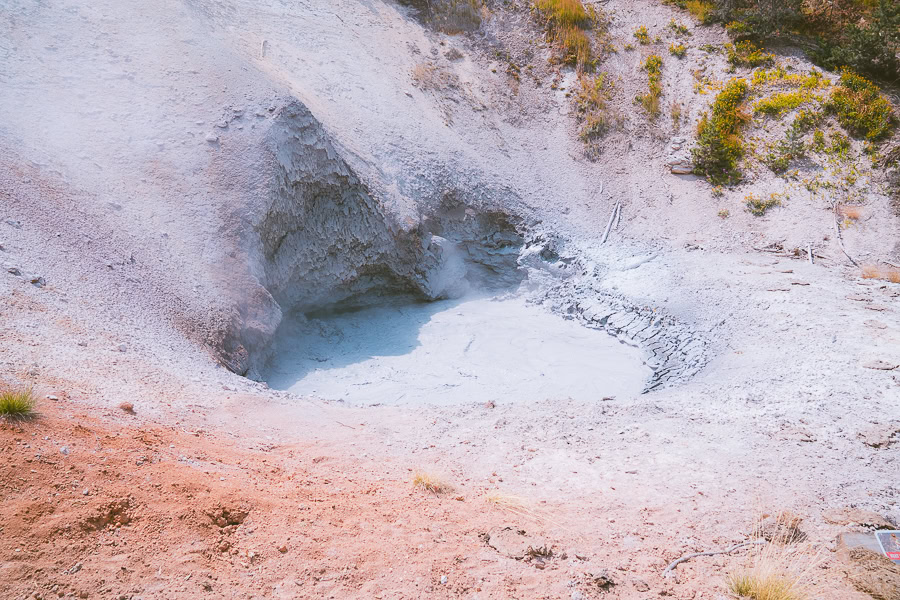
Accessible via Grand Loop Road, the Mud Volcano area boasts a series of boiling mud pots and steaming vents welcoming you with otherworldly sights and smells. The bubbling mud and steam create an eerie atmosphere as the pungent odor of rotten eggs rises to the skies.
This area is undeniably home to some of the most unique things to see when visiting Yellowstone National Park. The acidic mud pots in the area are due to a limited water supply. Some microorganisms use hydrogen sulfide as an energy source, converting the gas into sulfuric acid that breaks down the rock into wet clay mud and gives it a horrendous smell.
Keep in mind that when exploring this area, you should always stay on the boardwalk or the designated viewing areas. Do not run, push, or shove, as contact with the hydrothermal water can lead to severe burns. If you’re visiting with children, always keep them supervised.
Explore Hayden Valley
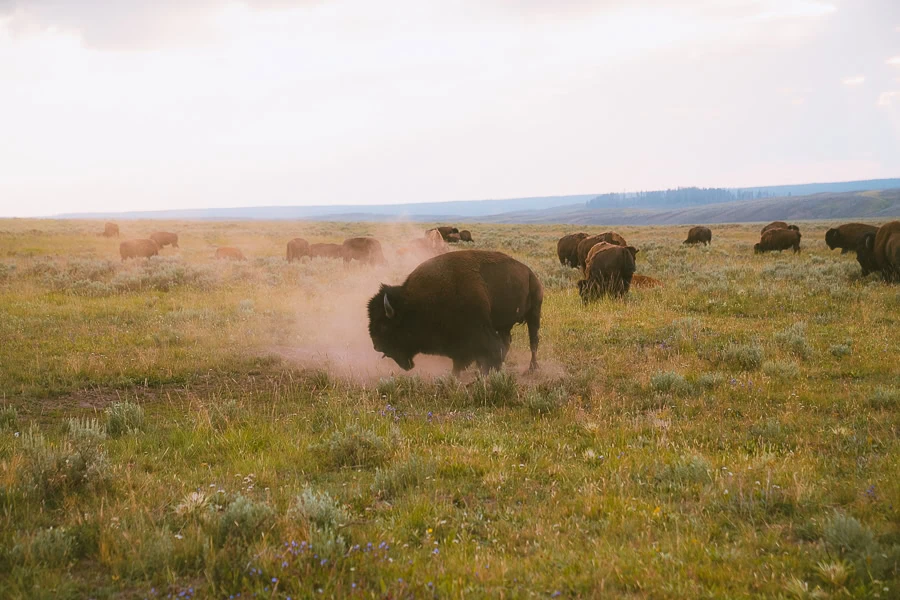
Set along the Yellowstone River, Hayden Valley is centrally located in the national park and is a fantastic place to go wildlife spotting. The wide-open grasslands, winding Yellowstone River, and distant mountain ranges in the background create a conducive environment for the animals.
This area is historically significant as it was a hunting ground for Native American tribes and later settlers, which makes sense considering the roaming wildlife. While driving through the picturesque valley, keep your eyes peeled for bison, elk, and occasional grizzly bears.
Hayden Valley is the perfect spot for birdwatching. The area sees a lot of ducks, waterfowl, Canadian geese, and pelicans lounging or splashing around in the Yellowstone River.
Day 2 of Your Yellowstone National Park Itinerary
Day two of your Yellowstone itinerary takes you to some of the most famous erupting geysers in the national park. You’ll also get to see a couple of cascading waterfalls.
Visit Old Faithful Geyser
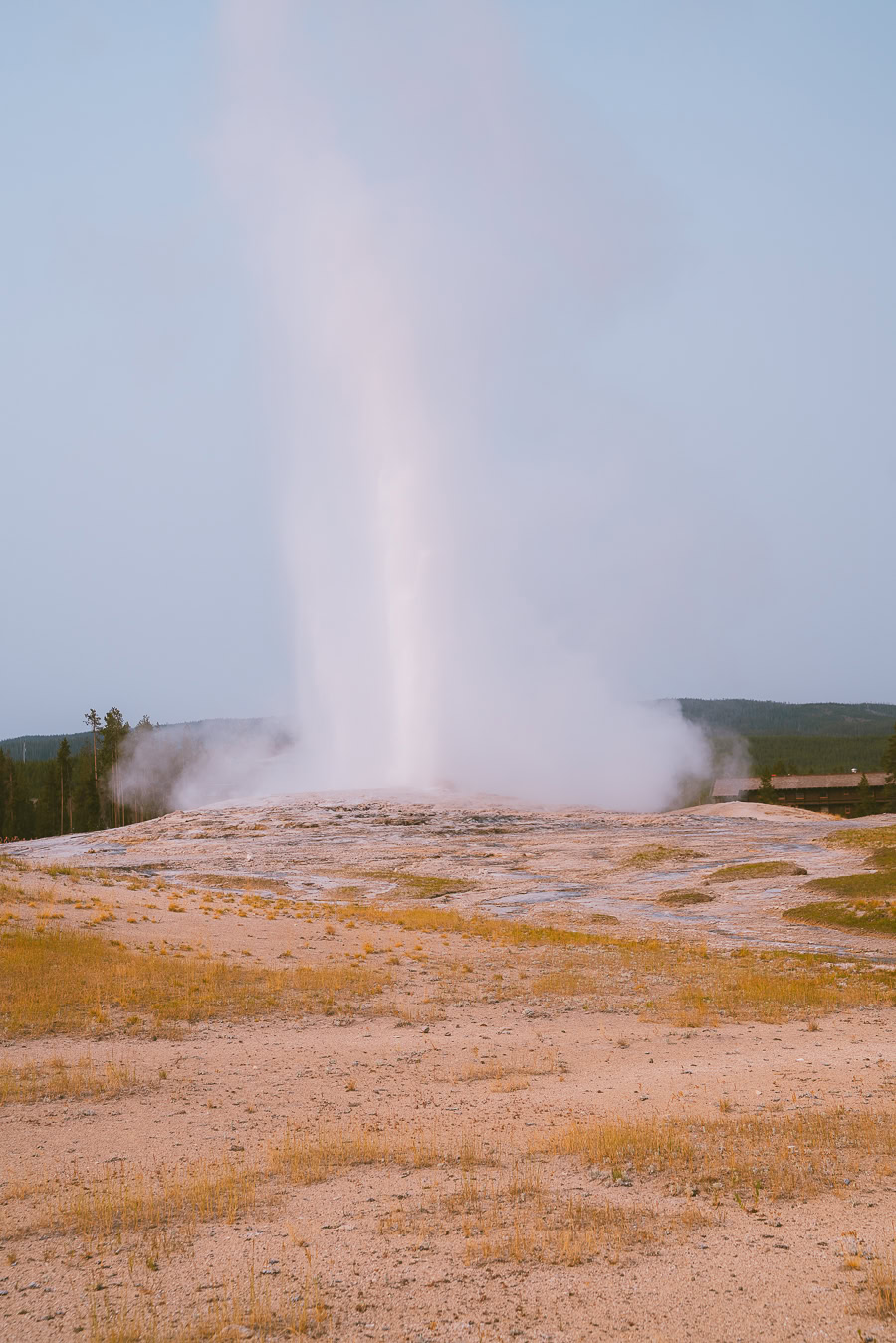
Situated in the Upper Geyser Basin, Old Faithful is surrounded by other colorful thermal pools and geysers set against the lush backdrop of the Teton Range. Old Faithful is one of the most predictable geysers in the world, giving you easy access to an eruptive show.
The Old Faithful Geyser Observation Deck is visitor-friendly, boasting ample seating to sit and admire the spectacle. You’ll find an impressive visitor center with a museum, a store, and restrooms. It’s also within walking distance from the ranger station and Old Faithful Inn.
To catch the next eruption of Old Faithful Geyser in all its glory, keep an eye on the timer in the visitor center, which tracks and tries to predict the next eruption time, length, and height.
Explore the Thermal Pools at Biscuit Basin and Black Sand Basin
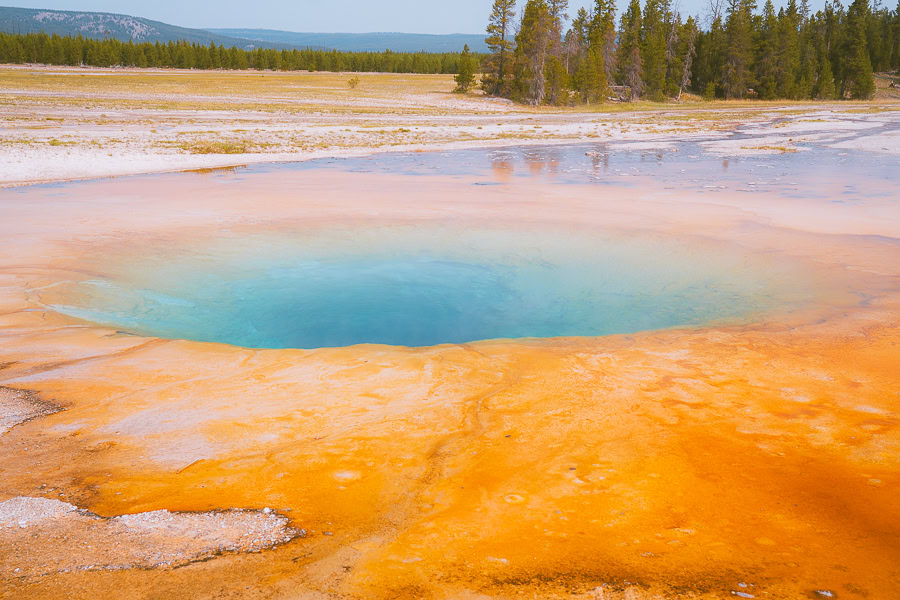
Experience the rest of Yellowstone’s beautiful Upper Geyser Basin by exploring these two kaleidoscopic thermal pools. Both are just a skip away from the Old Faithful Geyser. These basins are tastefully surrounded by lots of walkable boardwalks and lush vegetation.
Although it’s small, the Black Sand Basin features a number of vibrant thermal features, like the Emerald Pool, Cliff Geyser, and Rainbow Pool. This breathtaking basin gets its name from the dark rock, obsidian, which forms when lava cools down too quickly.
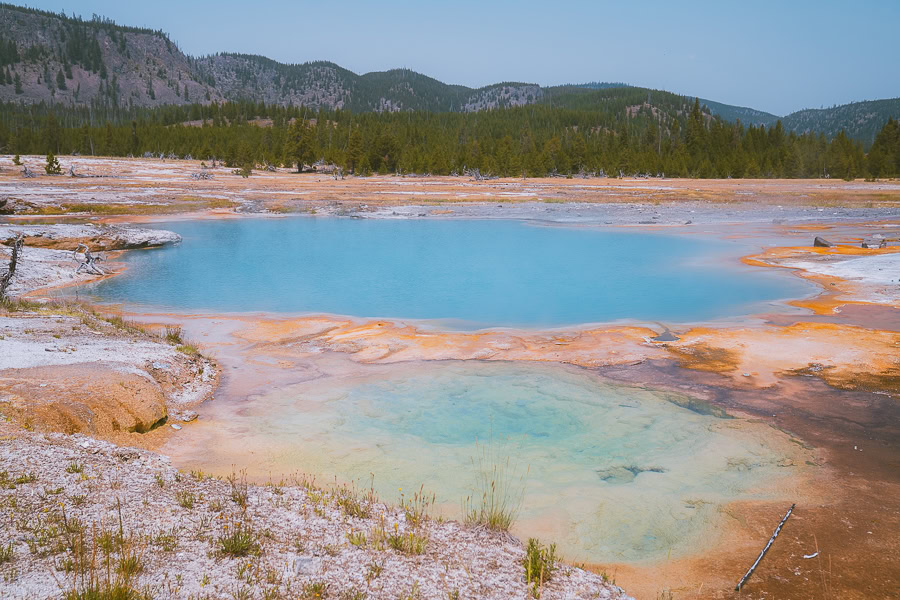
After marveling at the Black Sand Basin, head over to Biscuit Basin for a fun continuation of stunning natural scenery. Explore the Biscuit Basin via a short 0.6-mile lollipop loop trail that traverses through fascinating hydrothermals like Jewel Geyser and the iconic Sapphire Pool.
Visit Grand Prismatic Spring (See Both Viewpoints)
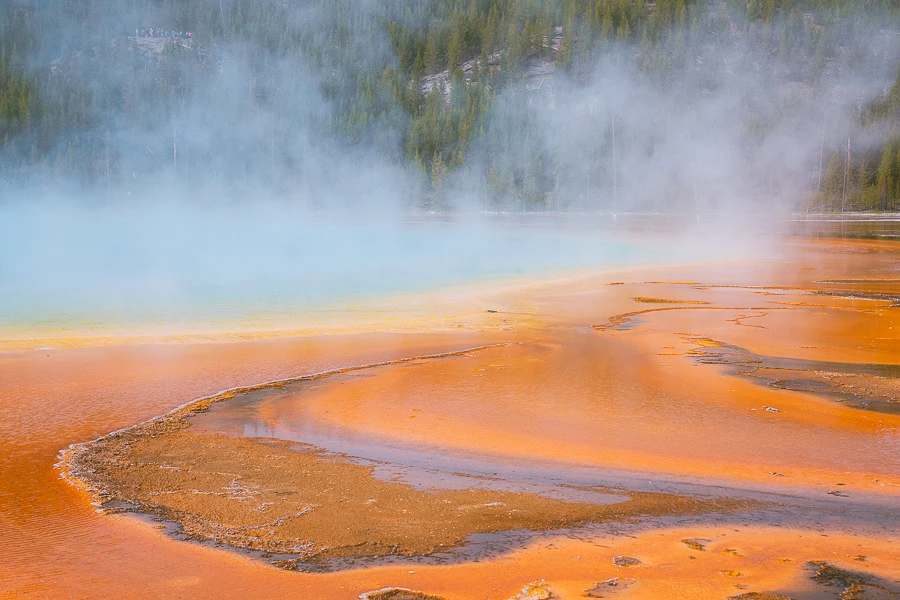
Ranked as the largest hot spring in the United States, Grand Prismatic Spring is undeniably one of the most spectacular sights to see in Yellowstone. Set in the Midway Geyser Basin, the hot spring boasts rainbow-colored hues vividly contrasting the surrounding landscape.
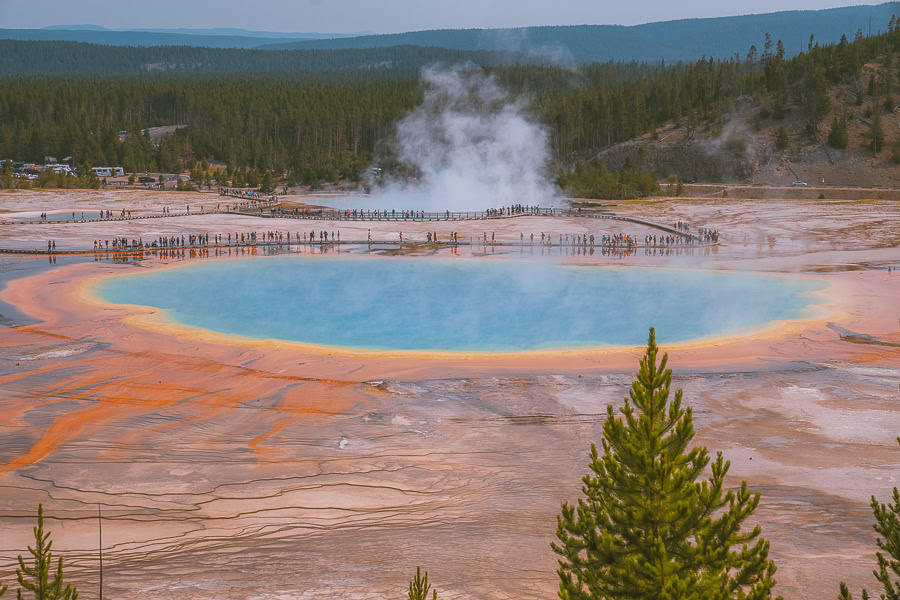
Views of the Grand Prismatic Spring are truly captivating from up close and from an elevated point. You should definitely try seeing the hot spring from both viewpoints. First, hike the Midway Geyser Basin Trail Loop, passing Excelsior Crater, Opal Pool, and Turquoise Pool.
The second way to admire this natural wonder is at the Grand Prismatic Overlook. Access the trailhead one mile south of the Midway Geyser Basin at the Fairy Falls Parking Lot. Expect a gradual incline to over 100 feet, and after two hours of walking, you’ll be looking down at mesmerizing views of Grand Prismatic Spring.
Hike to Fairy Falls
- Distance: 4.8 miles out-and-back
- Elevation Gain: 170 feet
- Difficulty: Easy
- Trail Guide: Link
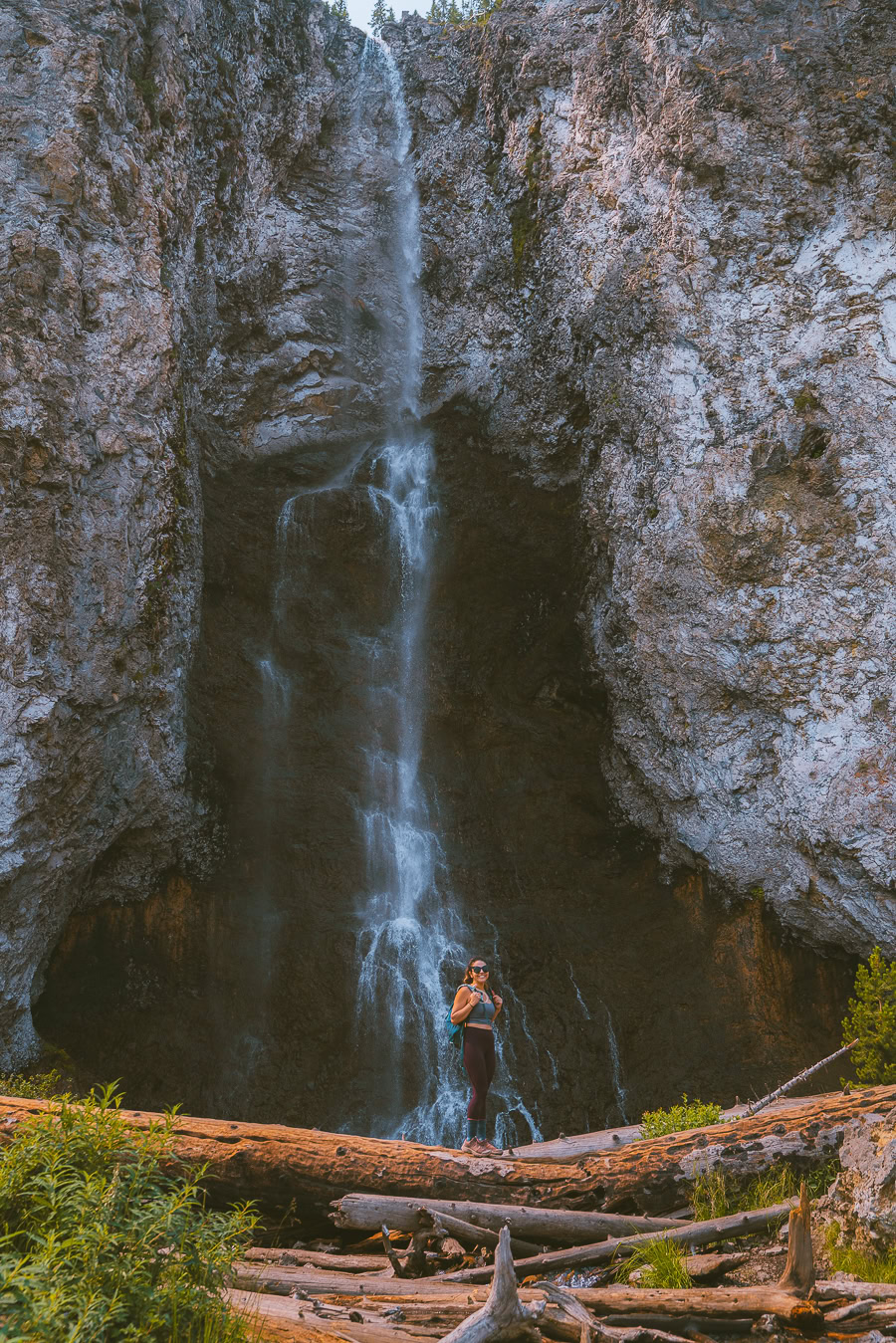
Standing at 200 feet, Fairy Falls is one of Yellowstone’s most impressive waterfalls. It also provides one of the best hikes in Yellowstone National Park, so brace yourself for a thrilling adventure that ends with a tumbling cascade.
Nestled in a dense forest, Fairy Falls offers peaceful surroundings, ideal for taking loads of photos. Enjoy an easy trek along the flat Fairy Fall Trail, accessible right off Grand Loop Road. It’s recommended to hike to Fairy Falls in the afternoon to avoid the midday heat.
Otherwise, you can stretch the length of your hike by combining it with a trek past the Grand Prismatic Viewpoint from the Fairy Falls Parking Lot. This is a great hike to immerse yourself in Yellowstone’s diverse ecosystem and natural splendor.
Stop at Gibbon Falls
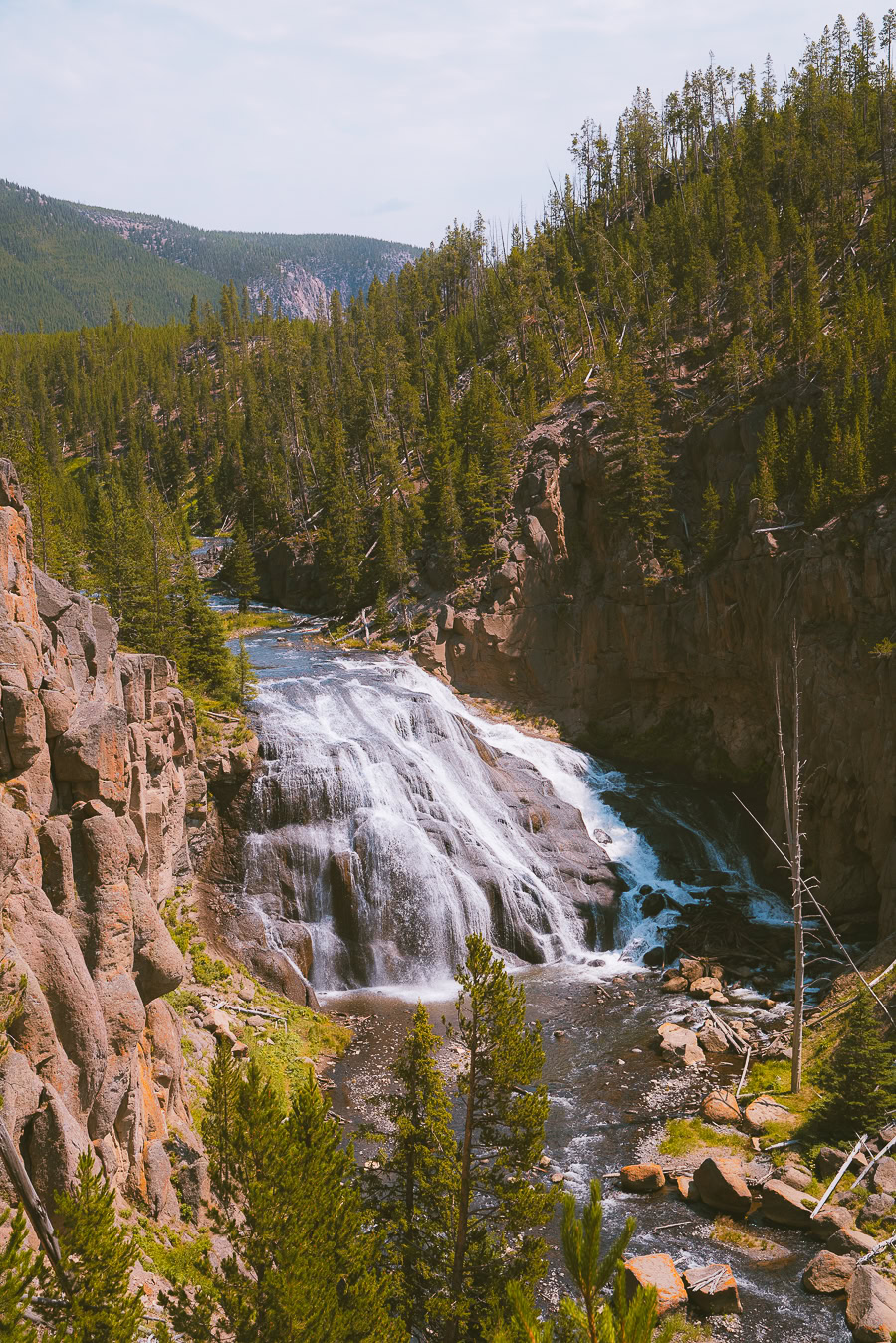
Set along the mighty Gibbon River, these 84-foot-tall falls are among the most accessible waterfalls in Yellowstone. They are located just off Grand Loop Road, offering you the perfect quick stop when traveling to Norris Geyser Basin or the park’s north entrance.
Gibbon Falls drops off the remains of Yellowstone’s caldera rim, which was a result of a massive volcanic eruption that took place over 600,000 years ago. Enjoy excellent views from the designated parking area near the top of the falls, but you’ll have to wait your turn.
Due to its small size, the parking lot can get quite congested, causing a delay. If you want to avoid the crowds, be sure to follow the paved Gibbon Falls Wildlife Trail to claim your spot.
Visit the Artists Paintpots
- Distance: 1 mile loop
- Elevation Gain: 101 feet
- Difficulty: Easy
- Trail Guide: Link
Named after the colorful, paint-like mineral deposits, Artists Paintpots offers geothermal features comparable to no other attraction in the park. Located about three miles south of the Norris Geyser Basin, this area is bubbling with mud pots and colorful hot springs.
Access the trailhead from a parking lot sitting about half a mile from Grand Loop Road. Here, you’ll find basic vault toilets and the starting point of Artists Paintpots Trail. As you walk along the loop, you’ll come across a partially burned pine forest before winding through a meadow.
While strolling on the boardwalk, keep your eyes open for the red, yellow, and milk-blue colored hot springs, mud pots, and small geysers. Note that this path is a bit more rugged than its southern counterpart, Fountain Paint Pot Trail, sitting amidst lush pines and grass.
Grab Your Free Car Camping Checklist! 🚗🌲
Ready to elevate your car camping game? Snag our essential checklist to ensure you’ve got everything you need for a stress-free, fun-filled adventure! Perfect for beginners and seasoned campers alike. Download now and hit the road prepared! 🌟🎒
End the Day at Norris Geyser Basin
- Distance: 2.9 miles loop
- Elevation Gain: 190 feet
- Difficulty: Easy
- Trail Guide: Link
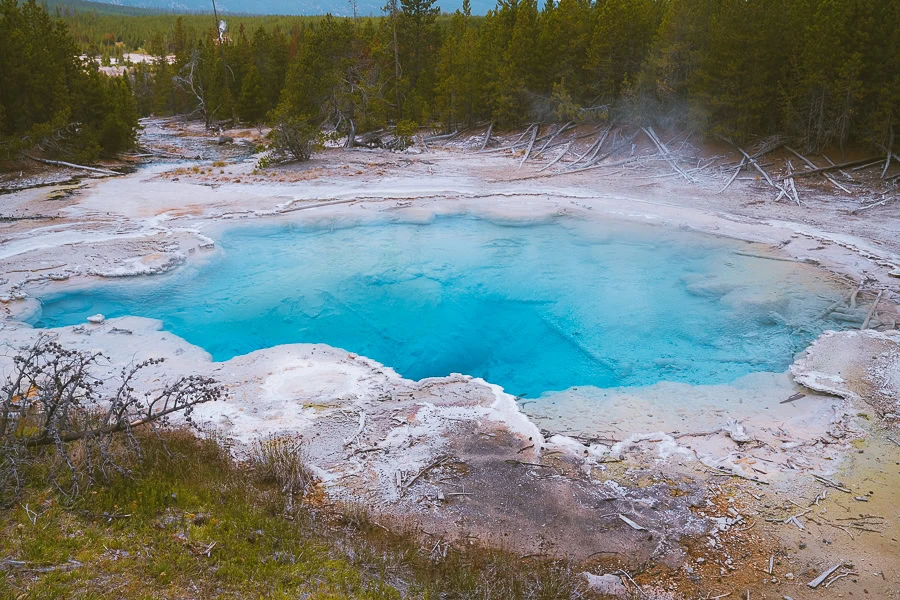
Famous for being home to the hottest and most acidic thermal pools in Yellowstone, the Norris Geyser Basin is packed with geysers, hot springs, and steam vents ready to explore. The atmosphere is quite surreal, with steam rising against backdrops of colorful mineral deposits and barren landscapes.
This area can be explored by trekking two separate loops or combining them into a super loop. The northern one is shorter and takes you past the likes of Ledger Geyser and Porcelain Springs. In the south, you can choose between two longer loops that traverse through other highlights in the area, like Emerald Spring and the Steamboat Geyser.
Day 3 of Your Yellowstone National Park Itinerary
Wrap up your three days in Yellowstone on a high by exploring one of the most extraordinary viewpoints in the national park before climbing up to one of its highest points. Spend the last day of your itinerary admiring a magnificent cascade, a rare hot spring, and plenty of wildlife.
Explore the Grand Canyon of the Yellowstone
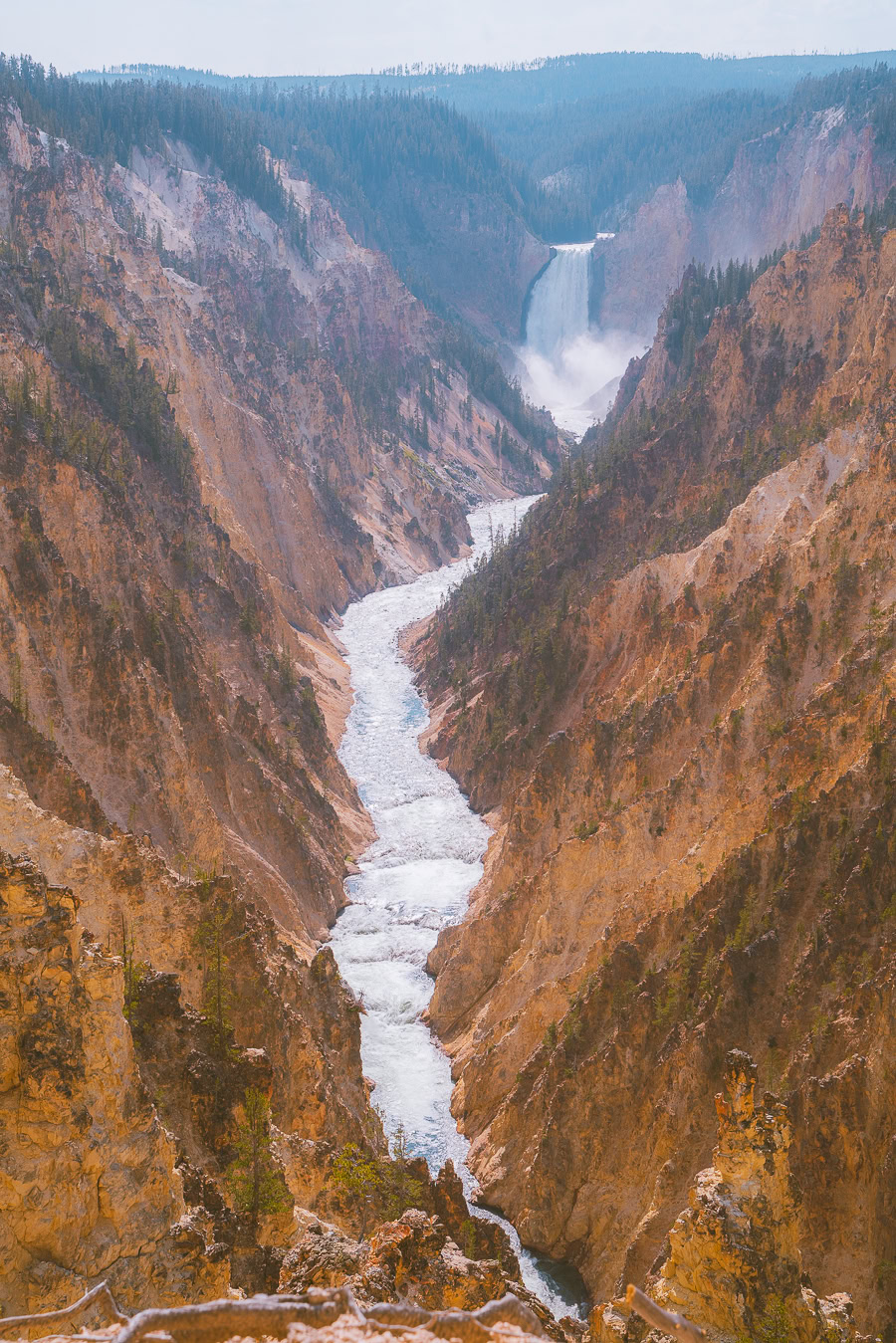
If you think you have seen all there is to see in Yellowstone, then you’re in for a big surprise. The Grand Canyon of the Yellowstone fully epitomizes this epic national park’s fascinating geological complexity.
But this Grand Canyon didn’t always look like this. Over 600,000 years ago, a massive volcanic eruption caused an outpour of magma deposits over many miles. But it was only about 150,000 years back that the Yellowstone River began slowly carving out this gem.
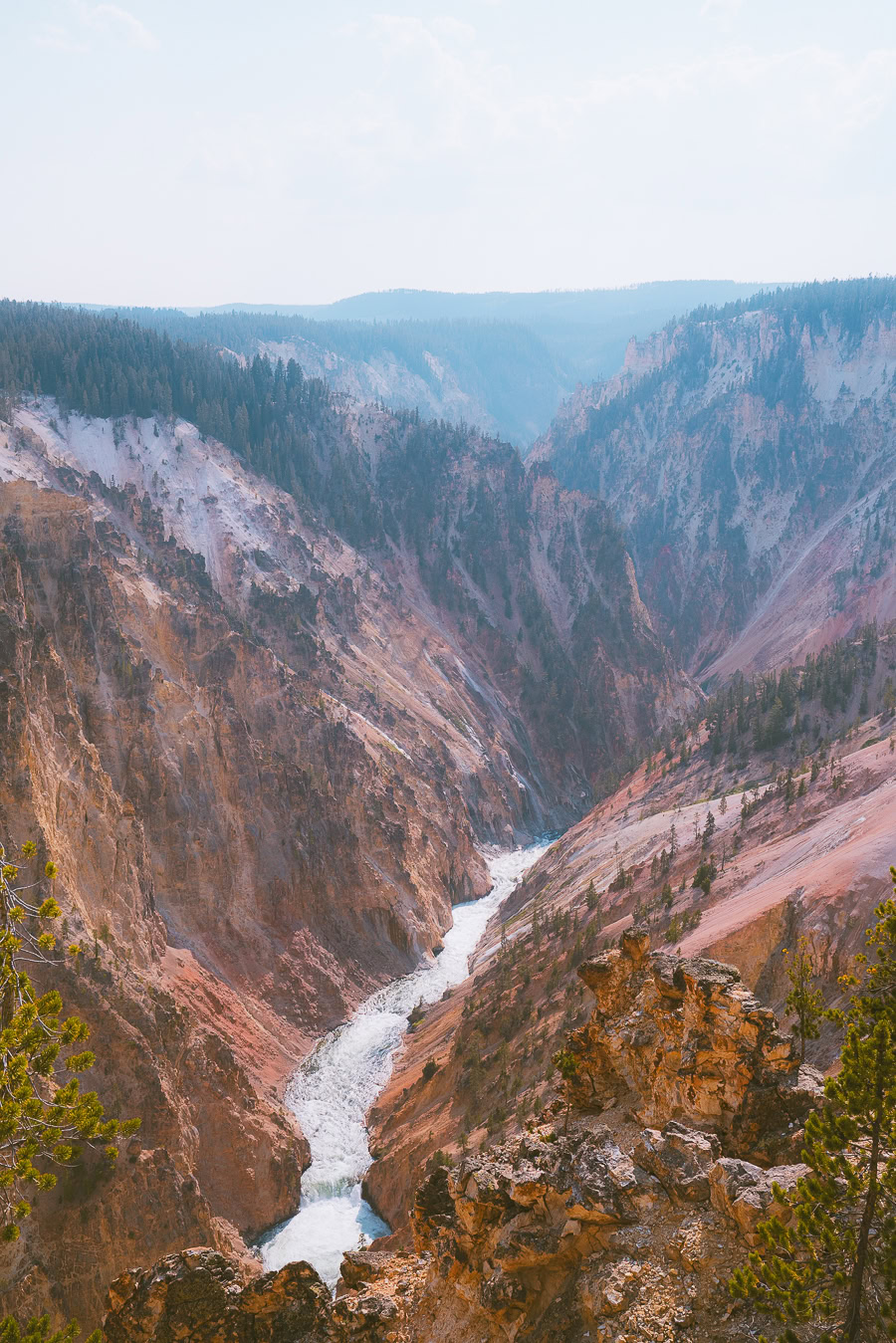
Navigating through the Grand Canyon may be a bit challenging, but you’ll soon figure it out. There’s plenty to do here, from hiking surrounding trails like the Brink of the Lower Falls and Uncle Tom’s trails to marveling at stunning vistas like Upper Falls View and Inspiration Point.
Hike the Mt. Washburn Trail
- Distance: 6.8 miles out-and-back
- Elevation Gain: 1,394 feet
- Difficulty: Moderate
- Trail Guide: Link
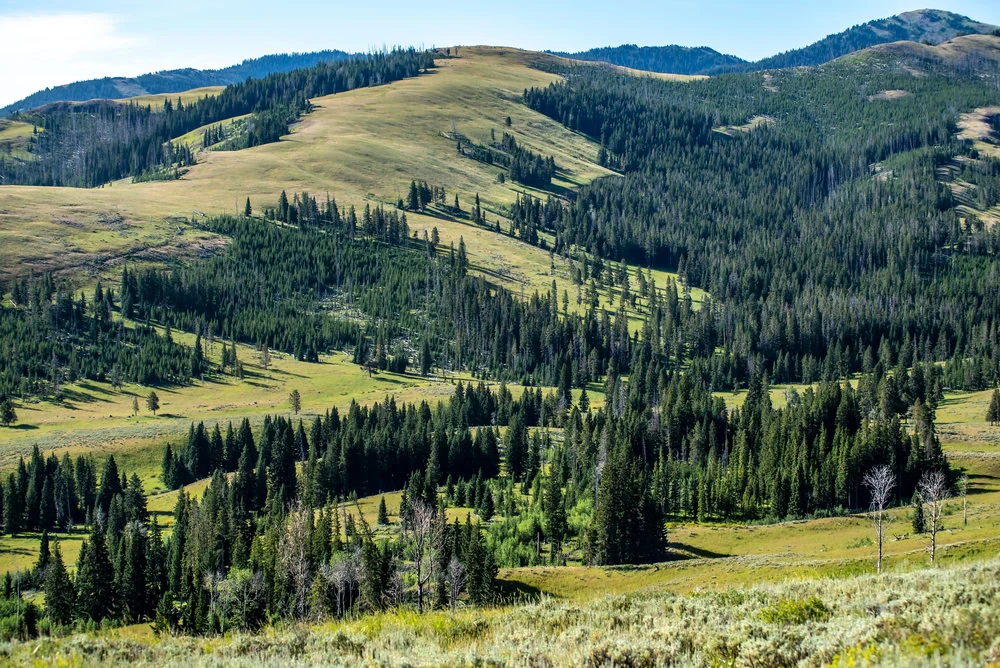
Go on a rewarding hike to the summit of Mt. Washburn for panoramic views of Yellowstone. Tucked between Tower Falls and Canyon Village, Mount Washburn gives you access to one of the highest points in the national park, topped off with spotting wild animals and flowers.
Access this trailhead via the Dunraven Pass, about 4.5 miles north of Canyon Junction. This is a moderately challenging hike that could easily take about four hours to complete. So, you should aim for an early morning trek and keep on the path to avoid destroying the flora.
This hike offers an opportunity to spot roaming wildlife. Bighorn sheep are very popular in these parts, and so are grizzly bears in the fall when they’re looking for whitebark pine nuts.
View Tower Falls
- Distance: 0.9 miles out-and-back
- Elevation Gain: 301 feet
- Difficulty: Moderate
- Trail Guide: Link
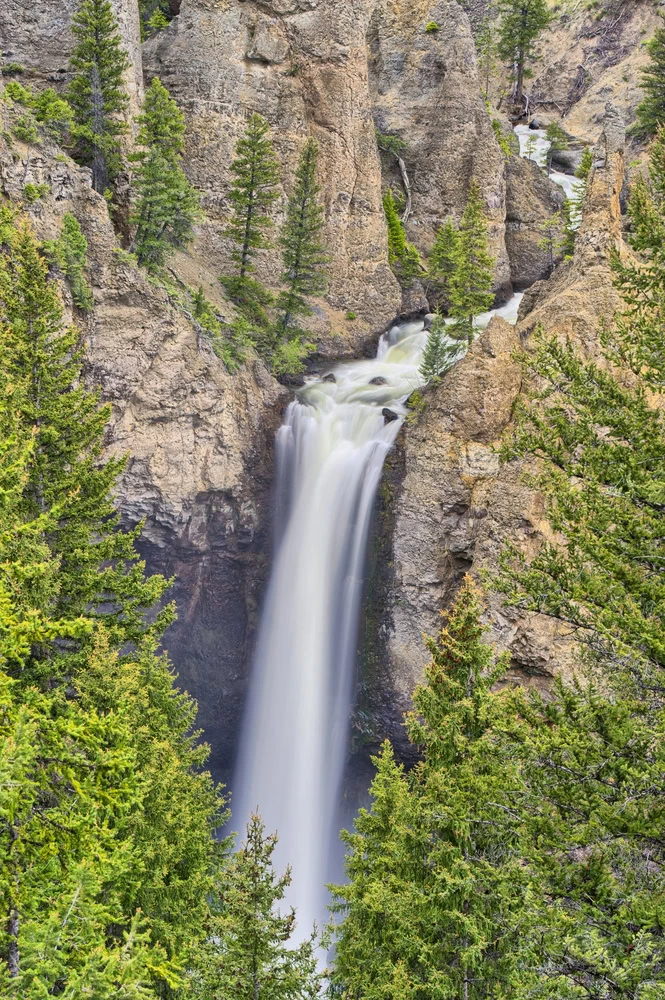
Located in the northeastern part of Yellowstone, less than five minutes away from Tower Junction, this incredible waterfall offers one of the best views in the national park. Plunging 132 feet, this waterfall is beautifully surrounded by towering cliffs and lush vegetation.
Before, people could hike down to the bottom of Tower Fall, but due to severe erosion, that path has been closed. So, the best way to admire this cascade is at the Tower Fall Overlook.
Walk three-quarters of a mile past the viewpoint, and you can see the Tower Creek flow into the Yellowstone River. The beginning of the Tower Fall Trailhead is marked by a general store and public bathrooms. Be on the lookout for bighorn sheep, falcons, and black bears.
Visit Lamar Valley for Wildlife Spotting
- Distance: 7.1 miles out-and-back
- Elevation Gain: 698 feet
- Difficulty: Moderate
- Trail Guide: Link
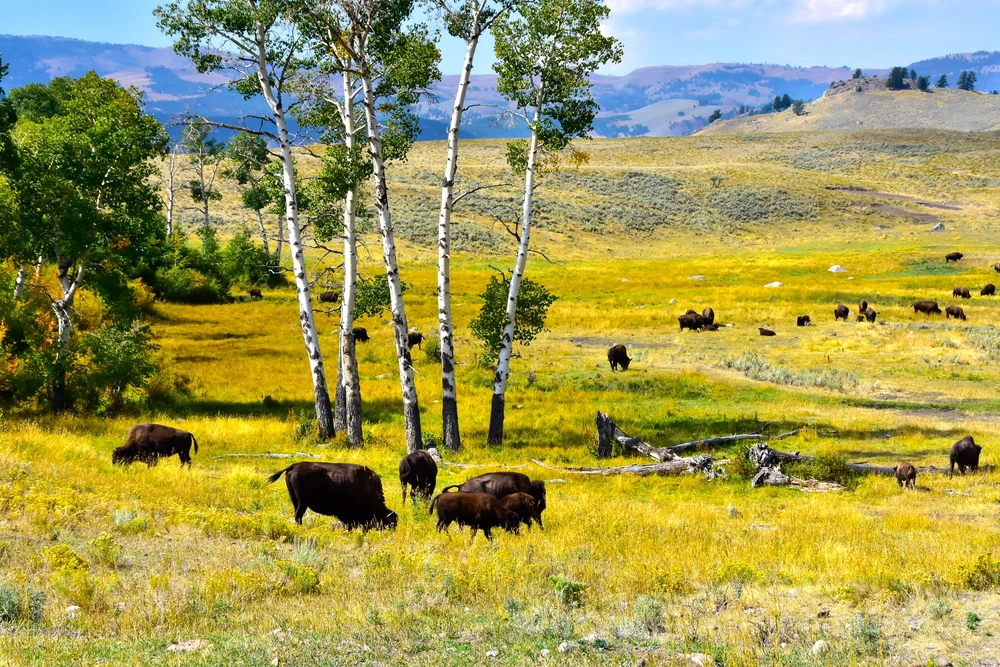
Located in the northeastern section of the park, Lamar Valley forms part of the Greater Yellowstone Ecosystem, also known as America’s Serengeti. So, there’s no need to visit Africa for a thrilling safari — just explore the verdant and animal-packed Lamar Valley.
From elk to bison and deer, large animals are easily spotted, thanks to the lush grasslands that provide food and grazing land. You’ll find some of the largest herds of elk and bison in North America here. Other critters like coyotes, cougars, and red foxes have been spotted.
Explore the Lamar Valley via a scenic drive. There are many pullouts along the road, giving you access to wildlife spotting spots, short trails, and overlooks of the lush surroundings.
If You Have Time, Explore Mammoth Hot Springs
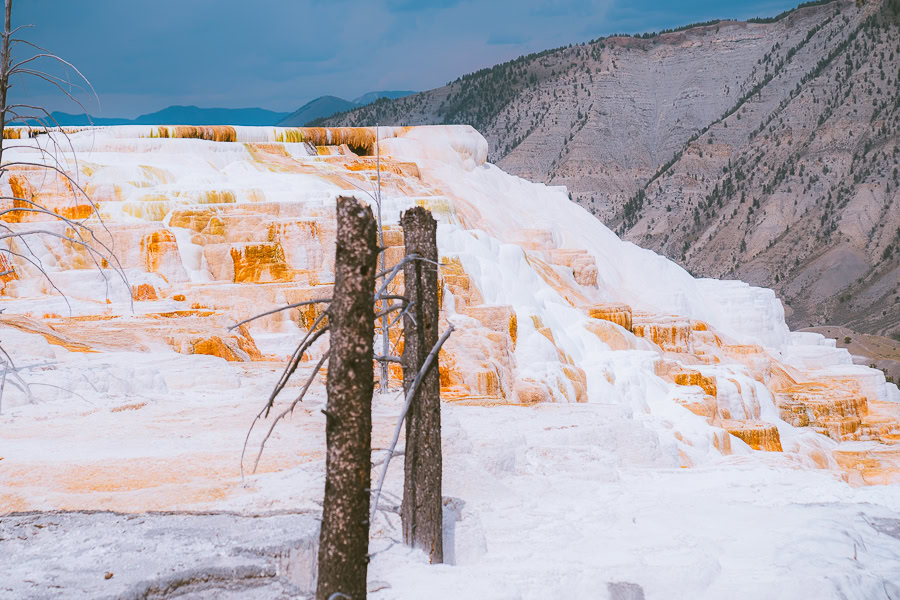
Set atop a travertine hill, Mammoth Hot Springs is one of the most unique places to visit in Yellowstone. Located about five miles south of the North Entrance, these hot springs are accessible via boardwalk trails to the viewpoints. You can also take a drive around the area.
While you can easily spend the day marveling at the terraces of white travertine, colorful mineral deposits, and steaming hot springs, you’ll find other interesting things to do here. Visit Fort Yellowstone and soak in the seasonal Boiling River, or drive to Gardiner. This small town offers loads of bars and eateries to enjoy meals, as well as many hotels and lodges.
How to Get to Yellowstone National Park
Yellowstone is located primarily in the northwest corner of Wyoming but also slightly extends into Montana and Idaho. Hence, the park is accessible by car via several entrances, including the North, West, South, and East entrances.
Major airports near Yellowstone include Jackson Hole Airport (JAC) in Wyoming, Bozeman Yellowstone International Airport (BZN) in Montana, and Idaho Falls Regional Airport (IDA) in Idaho. You’ll then hire a rental car from any of these airports and drive to Yellowstone.
Join my Newsletter to receive my free Backpacking Checklist!
Subscribe to have posts delivered straight to your inbox!! PLUS, get my FREE backpacking checklist!
How Much Time Is Needed When Visiting Yellowstone

To fully immerse yourself in the park’s main attractions and highlights, a minimum of three to four days is highly recommended. This gives you ample time to explore the top attractions, from the Old Faithful Village to the Grand Canyon, as well as the iconic Norris Geyser Basin.
Best Time to Go to Yellowstone National Park
The best time to visit Yellowstone largely depends on personal preferences and desired activities. Generally, the summer months, running from June to August, are the most popular times to visit due to warm weather, open roads, and abundant wildlife. But this also means you’ll have to contend with larger crowds and higher accommodation prices.
Spring (April to May) and fall (September to November) offer milder temperatures, far fewer crowds, and great opportunities to see wildlife during mating seasons and vibrant fall foliage.
On the other hand, the winter season (December to March) provides a unique experience of snowy landscapes, as well as opportunities for cross-country skiing and snowshoeing.
Yellowstone National Park in Spring
Spring represents a time of renewal in Yellowstone, with melting snow giving way to lush greenery and blooming wildflowers. Wildlife emerges from hibernation, and baby animals can be spotted throughout the park.
Enjoy mild temperatures, fewer crowds compared to summer, and the opportunity to witness dramatic waterfalls at peak flow. Note that some areas of the park may still be inaccessible due to lingering snow, and weather can be unpredictable, with occasional rain showers.
Yellowstone National Park in Summer
Summer is the peak season in Yellowstone, characterized by warm temperatures, long daylight hours, and a wide range of outdoor activities. You’ll witness iconic geothermal features, explore hiking trails, go wildlife watching, and enjoy scenic drives through the park.
Keep in mind that summer also brings large crowds, especially at popular attractions like Old Faithful and visitor centers. It’s important to book accommodations and activities months in advance and be prepared for busy roads and limited parking.
Yellowstone National Park in the Fall
Fall in Yellowstone is a spectacular time to visit, bringing vibrant foliage that paints the landscapes in shades of gold, orange, and red. Wildlife activity peaks as animals prepare for winter, making fall an excellent time for wildlife viewing and nature photography.
You’ll enjoy cooler temperatures, fewer crowds than in summer, and serene landscapes bathed in autumn colors. Fall also offers unique opportunities for hiking, camping, and enjoying the park’s scenic beauty without the long queues that come with summer crowds.
Yellowstone National Park in Winter
Winter transforms Yellowstone into a tranquil wonderland, with snowy landscapes and steaming geothermal features creating an appealing atmosphere.
While most roads are closed to vehicles due to snow, the park remains accessible for winter activities such as cross-country skiing, snowshoeing, snowmobiling, and wildlife watching.
You’ll witness iconic landmarks like Old Faithful against a backdrop of snow and experience the park’s geothermal wonders in a peaceful setting.
Read More: Best Time to Visit Yellowstone National Park 2024 Guide
Where to Stay in Yellowstone National Park
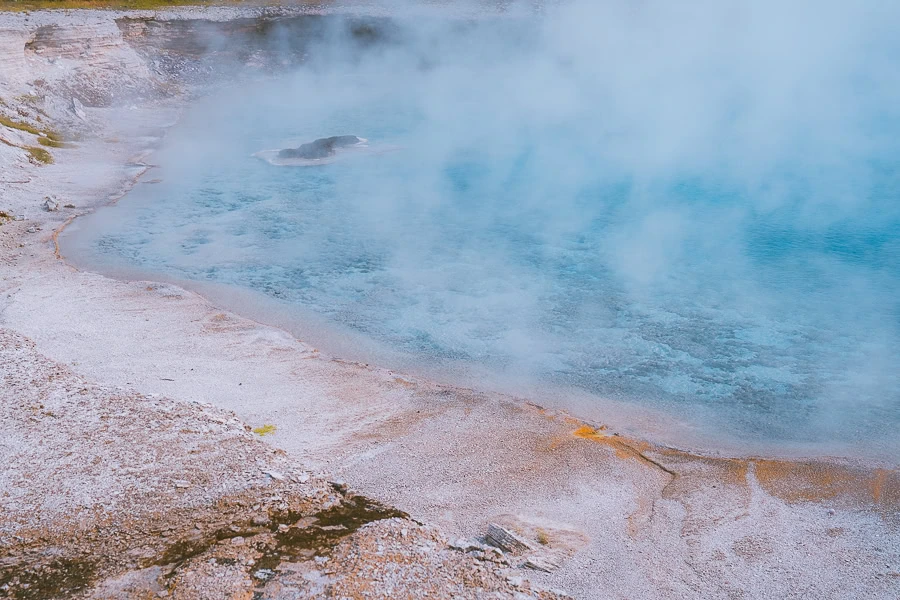
As one of the most visited national parks in the United States, Yellowstone sees many tourists throughout the year. While some seasons welcome more visitors than others, the park and its nearby towns are more than capable of delivering star-rated accommodation.
Consider these hotel recommendations when looking for a place to stay in Yellowstone:
Luxury | Yellowstone Park Hotel
Located just three blocks away from the park’s west entrance, this star-rated hotel in West Yellowstone offers you an excellent blend of comfort and convenience at your fingertips.
Step into your cozy retreat, where modern amenities meet rustic charm. Each guest room features a flat-screen satellite TV, ensuring you stay entertained after a day of exploring the park’s wonders. You’ll also enjoy the indoor pool and have access to bike rentals for tours.
Need a pick-me-up? Brew a fresh cup of coffee with your in-room coffee maker, or store your snacks and drinks in the handy microwave and refrigerator. But that’s not all you can look forward to; the hotel also gives you easy access to the Grizzly & Wolf Discovery Center. >>>Check Availability

Note: Yellowstone Park Hotel operates seasonally. The hotel reopens on May 3, 2024.
Mid-Range | The Cody Hotel
Nestled just 45 minutes away from the awe-inspiring wonders of Yellowstone, The Cody Hotel offers you a scenic drive into the national park via the east entrance.
Unwind in your spacious guest suite, where modern amenities meet Western charm. Each room features a microwave and refrigerator for your convenience, along with a flat-screen TV and DVD player for entertainment.
Ready to kick back and relax? Take a dip in the inviting indoor pool or soothe your muscles in the rejuvenating waters of the hot tub. Stay active in the well-equipped gym or catch up on work at the business center, all while enjoying complimentary Wi-Fi throughout the hotel. >>>Check Availability
Budget | Big Bear Motel
Nestled less than a mile from the exhilarating Cody Stampede Rodeo, this lovely motel offers the perfect mix of convenience and relaxation for your Wild West getaway.
Dive into relaxation in the oversized outdoor heated pool, where you can soak up the Wyoming sunshine and unwind after a day of adventure. During summer, immerse yourself in the spirit of the Old West with free horse rides and live Western music in the evenings.
Each room at Big Bear Motel features a flat-screen cable TV, a seating area, and a private en suite bathroom for your comfort. Enjoy the fresh mountain air from your own private patio, offering the perfect spot to sip your morning coffee and take in the serene surroundings. >>>Check Availability
Read More: Where to Stay in Yellowstone National Park | 9 Amazing Lodging & Yellowstone Hotels
Tours At Yellowstone
3-Day Yellowstone Itinerary | FAQs
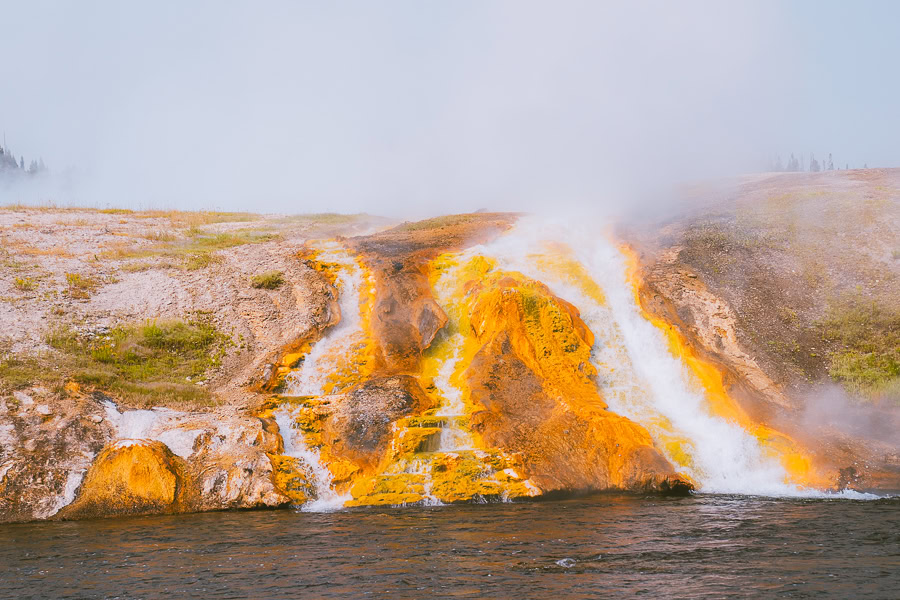
Are you still unsure about something regarding your Yellowstone road trip? Here are some commonly asked questions and their answers to keep in mind during your planning.
Where Should I Go for the First Time in Yellowstone?
For your first time in Yellowstone, start with iconic attractions like Old Faithful, Norris Geyser Basin, Grand Canyon of the Yellowstone, and Mammoth Hot Springs.
These highlights offer a perfect introduction to the park’s diverse geothermal features, breathtaking landscapes, and abundant wildlife. Don’t forget to take your time to savor the natural beauty and unique experiences that Yellowstone has to offer from various viewpoints.
How Long Does It Take to Drive the Loop in Yellowstone?
It takes approximately four to seven hours to drive the Grand Loop Road, depending on the traffic, road conditions, and stops you make along the way.
But, to fully experience the park and its attractions, allocate at least a full day or more for the loop, allowing you enough time for sightseeing, hiking, and wildlife viewing along the route.
What Is the Most Scenic Entrance to Yellowstone?
The most scenic entrance to Yellowstone is considered to be the North Entrance near Gardiner, offering views of Roosevelt Arch and the rolling landscapes of the northern range.
As you enter the park through this entrance, you’ll be greeted by sweeping vistas, iconic landmarks, and the sense of adventure that awaits within America’s first national park.
Are There Bears in Yellowstone National Park?
Yes, bears are present in Yellowstone National Park, including both grizzly bears and black bears. It’s important for visitors to be aware of bear safety measures and precautions.
Carrying bear spray is recommended when hiking or exploring the park’s backcountry trails. Bear spray is an effective deterrent that can help deter aggressive bears and provide added peace of mind while enjoying the wilderness of Yellowstone. Don’t use it unless you have to.
What To Pack For Hiking In Yellowstone National Park
There were only a few trails in Yellowstone that were worth hiking, but it is best to dress as comfortably as possible. Which is usually my hiking clothes (leggings, sports bra, and breathable shirts), and it was easy to transition when I wanted to hike.
- Sunscreen: Super important and because it was so freaking hot when we were here! >Buy Sunscreen
- Chapstick: This one has SPF so your lips won’t get burned! >Check Out This Chapstick
- Hiking Sandals: I used these sandals when we would go to all the lookouts. So comfy yet durable. >Check Out My Hiking Sandals
- Hiking Boots/Shoes: If you use tennis shoes, you can easily hurt your toes hitting a rock by accident (Trust me, I have done it so many times before). >Check Out My Hiking Shoes
- Hiking socks: Having the correct socks helps prevent getting blisters. Smart Wool is probably my favorite brand out there. >Buy Hiking Socks
- Water Reservoir: Water reservoirs help prevent dehydration while hiking. The great thing about this reservoir is that it doesn’t have a plastic taste. >Here Is My Water Reservoir
- Water: Stay nice and hydrated. It was soooooo hot when hiking here. Bring water to every hike.
- Sunglasses: It can get sunny in the summer, so make sure to pack some sunglasses. >Check Out These Sunglasses
- Snacks: The best snacks are jerky, nuts, and energy bars. >>>Check Out These Snacks
- Camera: The Sony A6000 was one of the first cameras I started traveling with. The Sony A6000 is an excellent camera for people that want to start improving at travel photography. >Buy Sony Camera Here
- First Aid Kit: This is one of the first things I bought when I first started going on adventures. It is super portable. >Buy This Awesome First Aid Kit Here
- Day Pack to carry all your things: To carry all your gear, water, and food, you need a good backpack. Osprey is known to have some of the best backpacks in the market. >Buy This Great Quality Backpack
- Headlamp: A headlamp is an absolute must in case you get stranded in the dark! It is a lot more portable and easier to use than a flashlight. >Buy A Headlamp Now
- Leggings or Hiking Pants: I usually wear leggings while hiking because it is what I feel most comfortable with! >Click For My Favorite Hiking Leggings
- Breathable sweat-wicking shirts: Cotton shirts soak up your sweat when hiking, so make sure to wear something breathable. >Check out this awesome breathable shirt here.
- Sports Bra: For women. >Check This One Here
- Jacket: Fall can get pretty chilly. >Buy My Favorite Jacket
- Rain Jacket: The worst feeling in the world is being wet and cold while hiking. You can get hypothermia, so always carry a poncho or a rain jacket when you hike Wyoming. Thunderstorms can happen. >Check Out My Rain Jacket Here
- Tripod: This is an optional item, but it is excellent for getting the ideal sunset pictures. >Check out this tripod
- Knife: I always carry a knife in my backpack just in case. >Check Out My Knife Here
- Bear Spray: There are so many bears here! Stay safe and hike with some spray. Everyone should carry one. >Check It Out Here
- National Park Pass: I highly recommend getting a year-long America The Beautiful Pass so you can get into both parks with ease. >Get It Here
- Map And Trail Guide: Start planning your trip with this. >Buy One Here
Claim your FREE Hiking Checklist
Ready to start hiking? Grab my free hiking checklist and never forget anything at home!
Your Ultimate 3-Day Yellowstone Itinerary | Wrapped Up
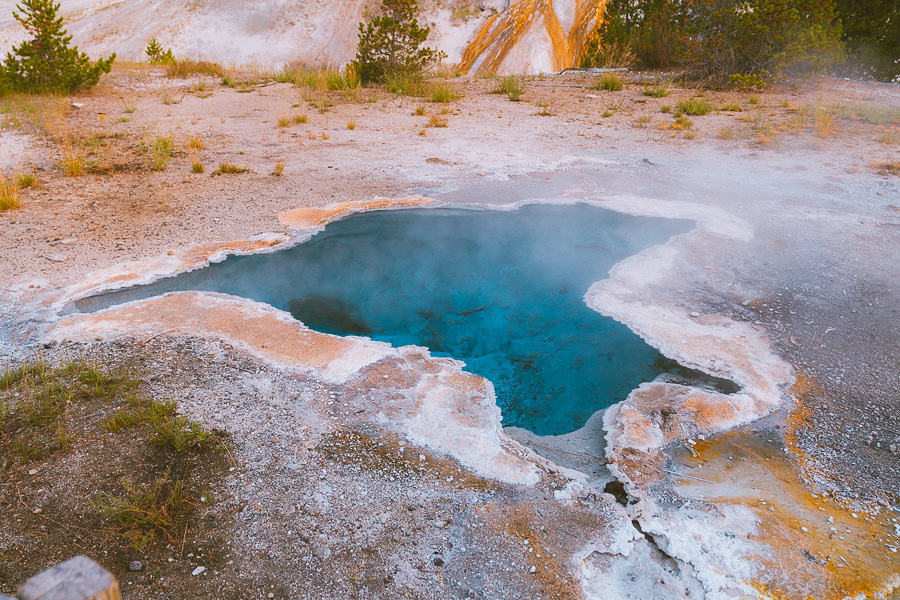
With this comprehensive 3-day itinerary, you’ll experience the best of Yellowstone, from its iconic geothermal features to its stunning landscapes and abundant wildlife.
Whether you’re captivated by the cascading waterfalls, colorful thermal pools, or the thrill of spotting bison and bears, the park promises an unforgettable adventure at any time of year. Summer gets the most visitors, but spring and fall introduce colorful wildflowers and foliage into the region. Winter presents a snowy adventure, with fewer crowds hovering around.
If you have more time to explore the region, it’s highly recommended to take a road trip to Grand Teton National Park. You can see top attractions, pristine lakes, and spot roaming wildlife at both national parks through a 7-day Grand Teton to Yellowstone road trip itinerary.
Next Read: Prepare for an epic Wyoming adventure and add these best hikes in Grand Teton National Park to your thrilling itinerary.

